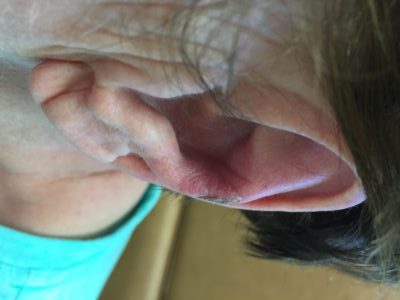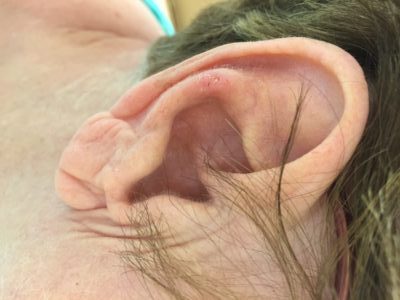What’s This Sore on my Ear?
Chondrodermatitis Nodularis Helicis
Doctor, what is this sore on my ear? Chondrodermatitis Nodularis Helicis (CNH), I reply. Yes, it is one of those conditions that dermatologists like to name to sound smart. In reality, though, this is a simple and common condition that is often stubborn to treat. Let’s break it down.
Chondrodermatitis – Inflammation of the cartilage (chondro) and skin (dermatitis)
Nodularis – forming a bump, callus or ulcer
Helicis – most common on the helix or antihelix (see Diagram) of the ear or other part of the ear that sticks out the farthest.

I like to describe this to patients as a pressure sore on the ear. When we lay on the ear at night (or have a helmet or hat), it puts pressure on the cartilage, the hard part of the ear. The pressure causes inflammation of the cartilage, which leads to irritation, pain, redness, callus, and/or ulcer of the skin overlying the inflamed cartilage.
This is most commonly seen on the sun-damaged ear of middle-aged and older adults, so sometimes, the patient may also have skin cancer or precancer occurring in the area of CNH. For this reason, often, we will biopsy persistent lesions to make sure there is not any additional cancer in the area.
The first objective in treatment is to avoid pressure on the ear by avoiding sleeping on that side; however, as seen in the patient photos, this often leads to a lesion on the new sleeping side. Another option is a CNH pillow or other similar pillow that would prevent putting pressure or the ear.

The second objective is to avoid infection of the area and encourage healing by gently cleansing and keeping the area moist with Vaseline, Aquaphor, or mupirocin antibiotic ointment.
The final objective is to reduce inflammation of the underlying cartilage as well as the skin. For persistent lesions or non-ulcerated lesions, we sometimes use topical steroids or injections with steroids to reduce the inflammation.
Finally, as previously mentioned, we want to biopsy any persistent lesions to evaluate for cancerous cells within the area.
If you have a persistently sore spot on your ear, try to avoid sleeping on it. If it does not resolve after a few months, see a dermatologist.
If you find these blog posts helpful, please share them on Facebook, Twitter or your social media preference using the buttons below. Also, email them to a friend!
If you would like to receive these posts in your email inbox Subscribe to our Site by clicking on this link.
|